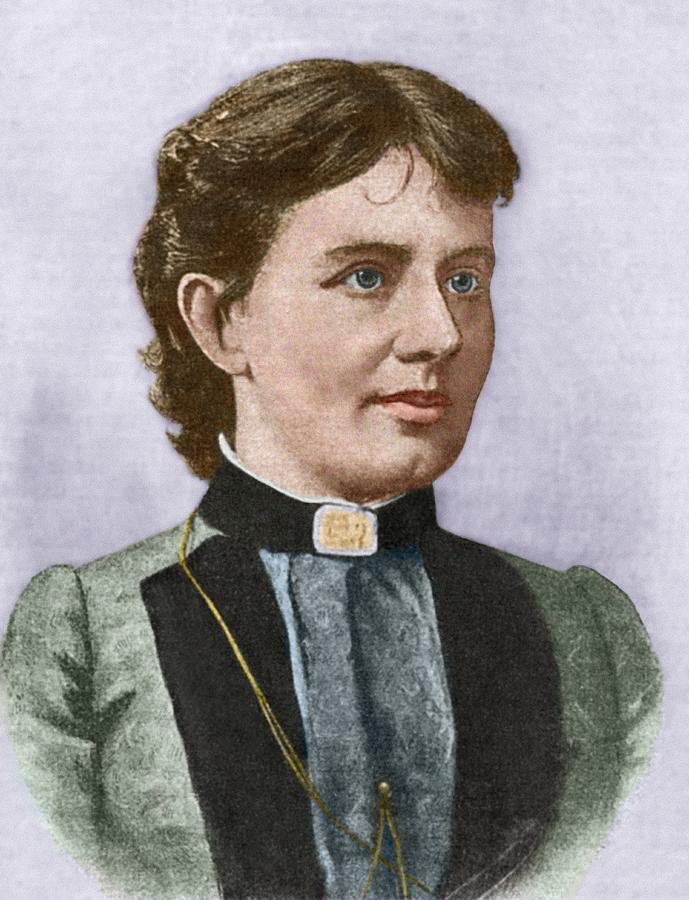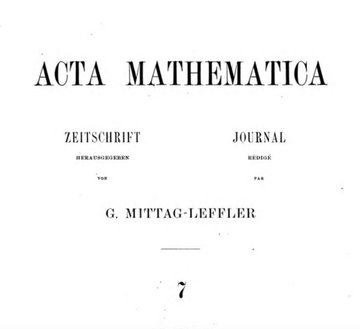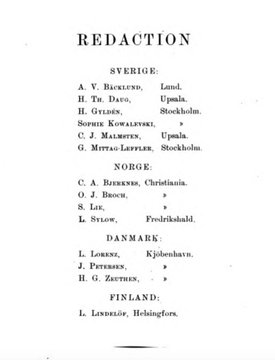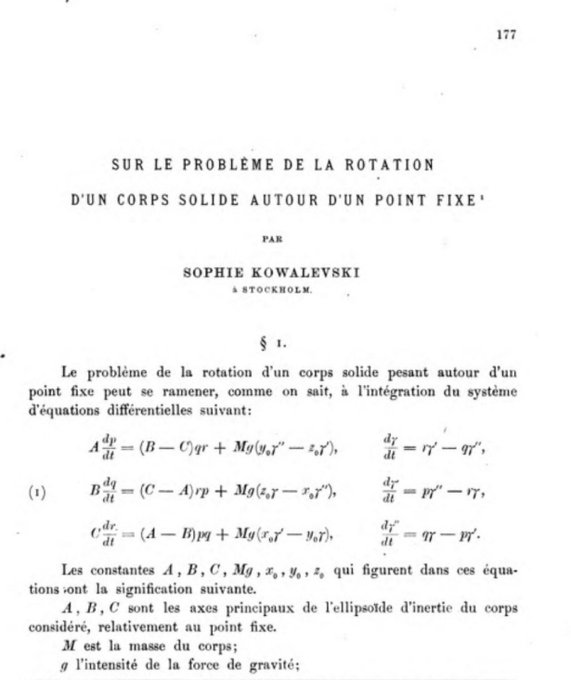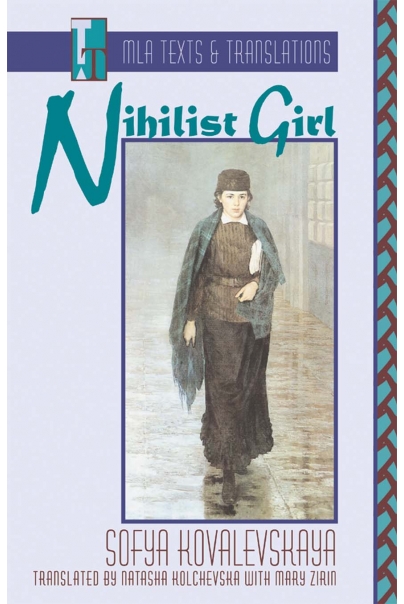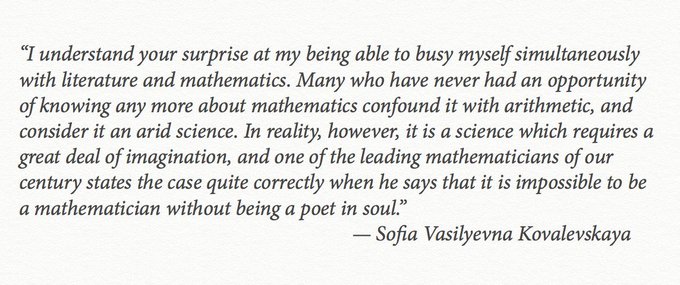Sofya Kovalevskaya was born #OTD in 1850. She was the first woman to earn a doctorate in mathematics in modern Europe, be appointed to a university chair, and join the editorial board of a scientific journal. She also won the Prix Bordin from the French Academy of Science.
Sofya, who also went by Sonya, was born in Moscow. Her father was a nobleman who took the family from the city to a country estate.
She has quite an origin story: The family ran out of wallpaper, so they papered her room with calculus notes from her father’s time at university.
She has quite an origin story: The family ran out of wallpaper, so they papered her room with calculus notes from her father’s time at university.
"These sheets, spotted over with strange incomprehensible formulae, soon attracted my attention. I passed whole hours before that mysterious wall, trying to decipher even a single phrase, and to discover the order in which the sheets ought to follow each other."
As a child she was given a physics book by a family friend. It required trigonometry, which she figured out on her own. The family friend, amazed by her ability, convinced Sofya’s father to arrange a private tutor.
She excelled at mathematics, but women were barred from Russian universities at the time. So she entered into a marriage of convenience with a young geology student and went with him to Heidelberg. She couldn’t enroll there either, but at least she could attend lectures.
After wowing the professors for a few years, Sofia went to Berlin to study with Weierstrass. You remember Weierstrass: https://twitter.com/mcnees/status/1322542592010166272
Weierstrass wasn’t receptive, so he gave Kovalevskaya extremely difficult problems designed to discourage her. Sofya Vasilyevna Kovalevskaya solved his problems and Weierstrass became her ardent supporter.
He worked with Kovalevskaya for the next four years, charging her no tuition, and then arranged for her to apply for her doctorate from the University of Göttingen. She presented papers on partial differential equations, elliptic integrals, and the rings of Saturn.
Sofya was awarded her doctorate with honors in 1874, making her the first woman to earn a Ph.D. (as we now think of it) in math. However, finding a job was another matter.
For six years, from 1874 to 1880, Kovalevskaya tried to be a housewife. She would later recall this time as "the soft slime of bourgeois existence.” She and her husband had a daughter, Fufa, but separated in 1880. Sofia went to Paris and was elected to the Mathematical Society.
(Take a moment to consider the utter perfection of the phrase "the soft slime of bourgeois existence.”)
On Weierstrass’s recommendation the mathematician Gösta Mittag-Leffler helped Kovalevskaya find a position in Sweden. She became a lecture at the University of Stockholm in 1883. Some prominent Swedes objected to a female professor, but the University promoted her.
During that period Kovaleskaya joined the editorial board of Acta Mathematica. She was the first woman to hold such a position. There she is, listed in the Redaction, in an issue from 1885.
https://babel.hathitrust.org/cgi/pt?id=njp.32101044075834&view=1up&seq=8&size=125
https://babel.hathitrust.org/cgi/pt?id=njp.32101044075834&view=1up&seq=8&size=125
In 1886, Kovalevskaya entered the Prix Bordin contest sponsored by the French Academy of Science, for the best paper on the subject of the rotation of a solid body around a fixed point.
Like all entries, her paper "Sur le probleme de la rotation d'un corps solide autour d'un point fixé” was submitted anonymously. Contestants signed their papers with a quote. Her quote was “Say what you know, do what you must, come what may."
The judges overwhelmingly favored her treatment, which extended previous results on the rotation of symmetric objects to the case where an object’s center of mass is no longer on its axis. They were so impressed that they increased the amount of the prize by a full 2,000 francs.
Imagine entering a contest like this and the judges think your solution is so good that not only do you win but they have to increase the prize money.
When the judges announced the winner, they said that Kovalevskaya’s work "allows him to give a complete solution in the most precise and elegant form.”
Remember, the entries were anonymous. The judges assumed the author was a *him*.
Remember, the entries were anonymous. The judges assumed the author was a *him*.
Kovalevskaya continued to work on the subject, winning another prize from the Swedish Academy of Sciences in 1889. In June of that year she was promoted to chair of her department.
The great Russian mathematician Chebyshev was so impressed by Kovalevskaya’s work that he lobbied for her election to Russia's Imperial Academy of Sciences. He insisted on it.
How do you argue with a man who has a polynomial named after him?
The Imperial Academy of Sciences, the preeminent scientific organization in the country where Kovaleskaya had been refused a spot at univerisity because she was a woman, changed their rules to allow her election.
The Imperial Academy of Sciences, the preeminent scientific organization in the country where Kovaleskaya had been refused a spot at univerisity because she was a woman, changed their rules to allow her election.
In 1891, after returning from a trip to Italy, Kovalevskaya died from complications related to influenza and pneumonia. She was only 41.
Not surprisingly, given her experience with sexism in Tsarist in Russia, Kovalevskaya was involved in the Russian Nihilism movement. In 1890 she wrote a semi-autobiographical novel titled "Nihilist Girl."
https://www.mla.org/Publications/Bookstore/MLA-Texts-and-Translations/Nihilist-Girl
https://www.mla.org/Publications/Bookstore/MLA-Texts-and-Translations/Nihilist-Girl

 Read on Twitter
Read on Twitter